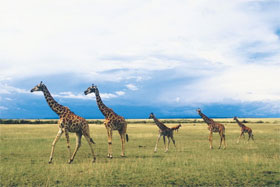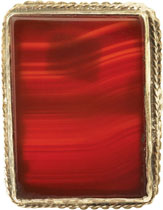Out of Africa
December 14, 06

Say “Kenya” to anyone with a bit of knowledge about colored gemstone resources and they inevitably mention tsavorite and ruby. The geologists Campbell Bridges and John Saul, both veteran ICA members, discovered the tsavorite and ruby deposits, respectively, in the Taita-Taveta districts in the 1970s.
Tsavorite, a green grossular garnet, is still mined in the Tsavo region, which remains the country’s chief gem mining area. Gem tourists often start their visit at the town of Voi on the western border of the Tsavo National Park, a town that is said to have been built chiefly with “tsavorite money.” Several companies, such as Equador, Hard Rock, and Aqua, are currently involved in ruby mining in the Kasigau and Mangare areas west of the park, where they also have come across sporadic pockets of tsavorite and chrome tourmaline. Gemstone tourism is becoming so popular of late that Aqua is finalizing plans to build a base camp there.
The famous “John Saul’s mine,” also known as the Rockland ruby mine, is located in the Mangare area. The new Megalith project is currently the largest mechanized mining operation in the area, if the size of its mining concession is anything to go by. However, as it is not completely on stream, it has not yet produced as much as the older mines. Most rubies viewed by buyers on site are of a fine cabochon grade, while the stones often seem to be candidates for heat treatment. Gem-quality stones are reported to have been mined mainly alluvially.
Tsavorite mining operations are underway in the Kuranze area, a few kilometers from the Tanzanian border, southeast of the Kasigau. Here, companies such as Bocrest Gem Enterprises, Tsavolite Mining, Mberilli and Nadan are mining this garnet variety. The Mwatate area in the Taita Hills on the other side of the Tsavo West National Park is home to Bridges Exploration, Baraka and Davis
Almost without exception, the tsavorite mining operations are of a smaller scale compared with the ruby mines, but mining processes are basically the same. The first step is to locate some alluvial deposits and then to find the primary deposit and mine it.
|
RUBY |
Mining tsavorite requires some serious practical geologic and mining knowledge in order to optimize the localization of the porphyroblasts or boudins, which are respectively called “potatoes” and “eyes” by the locals and are tsavorite-rich deposits. However, few local miners have the requisite technical mining or geological knowledge and it seems that, even for the most technically advanced miner, “being lucky” is the factor that makes the difference. High-quality rough displays deep bluish-green to green and yellowish-green colors. While plenty of attractively colored stones are mined, sizes remain small.
During a recent visit to Tsavo, ICA member Vincent Pardieu, observed a lack of any noticeable security problems or illegal mining occurrences. “All these mining areas are quiet, and the only ‘disturbances’ are caused by encounters with wild elephants, antelopes, and zebras, which are common around the mining operations. This is a good point for the miners which, in both [the] Kuranze and Mangare/Kasigau areas, are searching for investors in order to help them to develop their operations, mechanize their mines and market their production,” he noted.
Hundreds of miles north of Nairobi there is a very promising ruby and pink sapphire mining operation in the Baringo district, which is getting ready to start its mining operations in earnest after long preparation. The stones produced in this area present some different qualities, but most of them range from pink to red, with the pink and purplish dominating the deposit. The stones are found in alluvial deposits of basaltic origin.
Aside from these two areas, which are currently in production or on the verge of it, there are several other corundum deposits known in Kenya as Garba Tula (blue and green sapphire), or Turkana (sapphire). There are a number of areas all over the country, which, due to their location along the Mozambique belt, present very high potential for major future gemstone discoveries. All these areas are currently producing small amounts of gems, especially along the Ethiopian and Somali borders.
There is also a promising new ruby deposit producing stones in an undisclosed location. These are much more saturated in color than the gems found in the Baringo district. The samples found in this volcanic area look very similar to the rubies mined in the Thailand and Cambodia deposits. These new rubies present some serious hope for the Kenyan gem industry, as the stones are of commercial to very fine facet quality.
